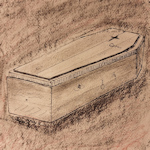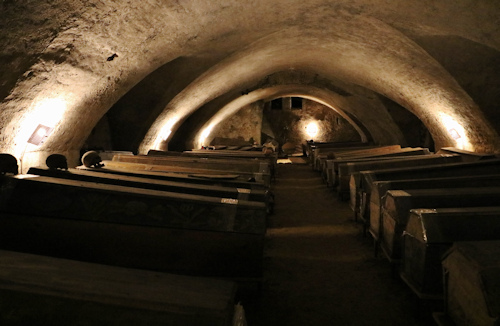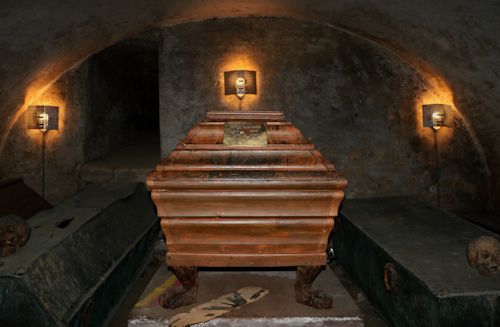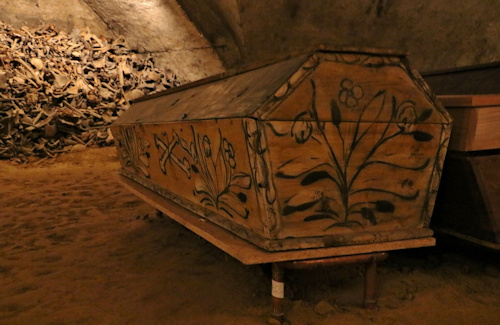
Travel back (down) into the past with a visit to the burial crypts of the Michaelerkirche church. A place to find the unexpected: like Italian poets and Austrian mummies.
- Crypts date back over 500 years
- Coffins, skulls and stories
- Check language availability, though
- Take a historical walking tour* of Vienna
- See also:
Skulls and silk

(View down the central crypt; press photo © Robert Passini)
Streams of people pass across Michaelerplatz square. They flow in and out of the Kohlmarkt shopping street or the majestic domed entrance to the Hofburg, whose statues see Hercules frozen in eternal conflict with the Hydra and Cerberus.
What few realise in all the modern hubbub is they are walking over a former cemetery. And, even today, the remains of hundreds of people lie only a few yards away…buried in the crypts of Michaelerkirche.
The church occupies one side of the square and first appeared when Vienna’s rulers were mere dukes and not yet emperors. The crypts came about as a consequence of a far-reaching Imperial edict.
Corpses being notoriously unhelpful for urban water quality, Emperor Maximilian I banned cemetery burials in the city in the early 1500s. Crypt burials, however, remained on the approved list.
And so the powers that be at the Michaelerkirche began to expand their underground spaces: not a simple undertaking when electric lighting and power tools are still centuries away.
A later Imperial edict under Emperor Joseph II in the late 1700s then saw crypt burials cease, too.
(A painted wooden coffin with a stack of bones behind; press photo © Robert Passini)
Fast forward to the 21st century…regular guided tours allow us to go down and explore those subterranean chambers.
(Not that the past is prepared to give up all of its secrets: some individual crypts remain sealed in stone.)
On my tour, steps took us down into the dusky and low-vaulted crypt chambers to reveal what looks like a medieval film set (and has actually served as a period drama film set).
The rows of wooden coffins feel quite orderly, and you might wonder where all the bodies are. Then the guide reveals you’re standing on a thick layer of bones and building materials. At which point, inevitably, you feel an urgent need to look down.
A little later, and you encounter wall niches full of skulls, femurs and similar, not to mention coffins with detached lids. I found myself waiting for a skeletal hand to appear (I’ve watched too much Game of Thrones).
The guide also took us to some of the private crypts filled with sturdier metal coffins belonging to noble families of the past …still striving (even in death) to be as close to the centre of power as possible; the Hofburg court was practically next door to the church.
All looks remarkably tidy compared to earlier days, when coffins would have been stacked on top of each other. Many collapsed under the weight of their fellows and the disintegrating touch of time and humidity.
Throughout the tour, our guide described the formal and cultural history of the crypts, offered intriguing anecdotes on crypt management through the ages, and dealt deftly with questions of all kinds: from the biology of mummification to Christian symbolism.

(The coffin of Pietro Metastasio; press photo © Robert Passini)
Quite apart from the atmospheric crypt experience, the Michaelerkirche version has three special attractions for visitors.
- The coffin of the famed court poet Pietro Metastasio (1698-1782), who lived next door in the Großes Michaelerhaus. His text La Clemenza di Tito provided the source material for the libretto to Mozart’s same-named opera, for example
- Painted coffins with symbols illustrating the transience of life and Christian motifs. Some have been restored and remind us that our impression of old coffins is coloured by the decay of passing centuries
- Mummies. Not what you expect in the heart of central Europe, but air shafts and variable microclimatic conditions meant some corpses underwent a process of mummification. We saw four still clad in their silk garments.
As a final treat, the tour also goes into a side chamber of the church. There, steps lead down to the last surviving part of the paved-over cemetery (thus revealing how much the street level has risen in the intervening years).
The chamber also features selected funeral items: simplistic copies of the insignia of power, like the Crown of the Austrian Empire, placed on the coffin when an emperor lay in state in the Michaelerkirche.
Tickets & visitor tips
Check the church website for tour times, prices and availability.
At the time of writing, tours were €8 for adult and in German, but they’ve had English tours in the past. My understanding is that you can accompany the German-language tours, but you will, of course, miss out on much of the information if not a German speaker.
For more darkened chambers and skulls (both real and decorative), try two more major crypt experiences in the very centre of Vienna:
- The Stephansdom catacombs: go on a guided tour of the crypts below the main cathedral
- The Kaisergruft: view the last resting place of dozens of emperors, empresses, and other imperial personalities.
All three crypt experiences make a nice change from summer temperatures if you’re looking to keep cool.
How to get there
Follow the travel tips at the bottom of the Michaelerkirche article.
Address: Michaelerplatz 5, 1010 Vienna
